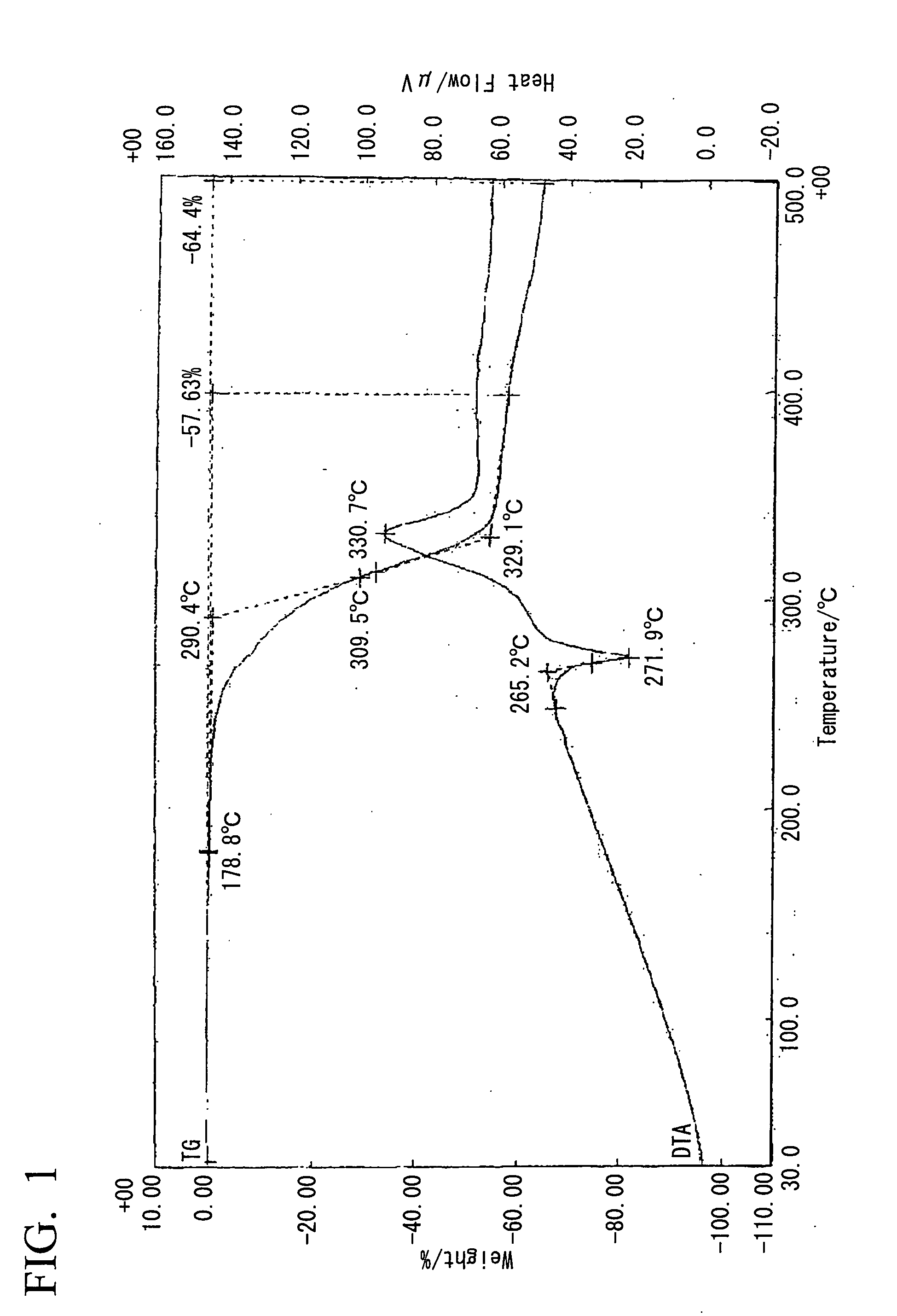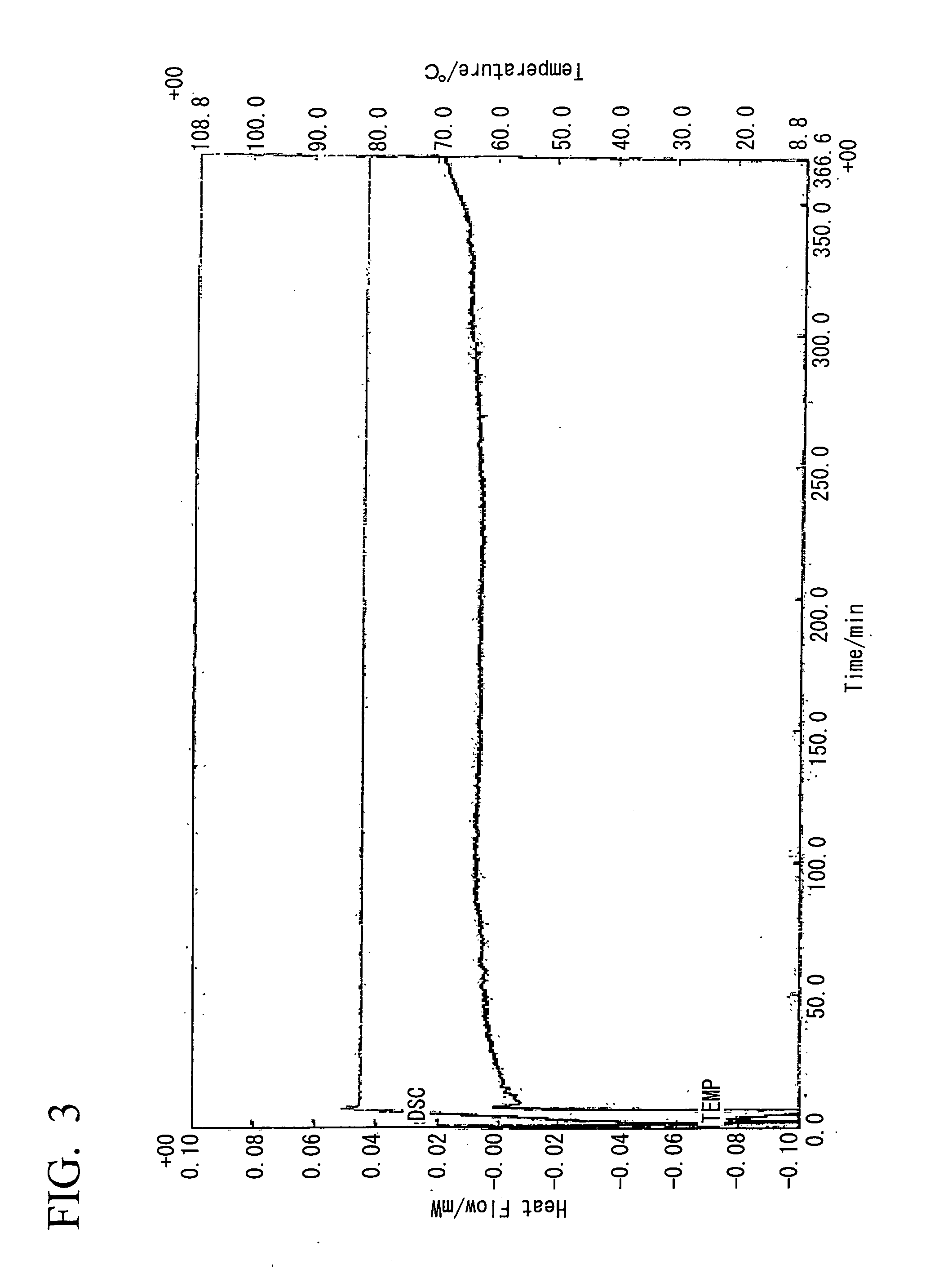Clathrate compound, curing catalyst, composition for forming cured resin, and cured resin
a technology of curing catalyst and compound, which is applied in the field of curing catalyst, curing compound, composition for forming cured resin, and cured resin, can solve the problem of extremely poor one-pot stability, and achieve the effect of improving one-pot stability and suppressing the curing reaction
- Summary
- Abstract
- Description
- Claims
- Application Information
AI Technical Summary
Benefits of technology
Problems solved by technology
Method used
Image
Examples
example 1
[0090]20 ml of a methanol solution containing 10 mmol (1.10 g) of 2-ethyl-4-methylimidazole was added to 20 ml of a methanol solution containing 5 mmol (1.05 g) of 5-nitroisophthalic acid under conditions of heated reflux with stirring. Although heating is subsequently stopped, crystals precipitate almost immediately, the mixture was left to stand overnight at room temperature, and then filtered and dried under vacuum, yielding a clathrate (0.5 g, 33%). Analysis of the obtained clathrate by NMR revealed 1:1 clathrate crystals. The 1H-NMR spectral chart and the X-ray diffraction pattern for the obtained clathrate (5-NO2IPA-2E4MZ) are shown in FIG. 18 and FIG. 19 respectively. For the purposes of comparison, the X-ray diffraction pattern for 5-nitroisophthalic acid (5-NO2-IPA) is also shown in FIG. 19. A thermal analysis (TG / DTA) chart for the obtained clathrate crystals is shown in FIG. 1. Furthermore, a thermal analysis (DSC) chart upon temperature variation for the obtained clathra...
example 2
[0091]15 mmol (3.33 g) of 5-t-butylisophthalic acid and 18 mmol (1.98 g, 1.2 eq.) of 2-ethyl-4-methylimidazole were added to 60 ml of methanol, and the resulting mixture was stirred under heated reflux in a round-bottom flask for 30 minutes, thereby dissolving the crystals. Subsequently, the solution was left to stand at room temperature, and the crystals that precipitated from the solution were filtered and dried under vacuum, yielding a clathrate compound (2.34 g, 47%). Analysis of the obtained clathrate by NMR revealed 1:1 clathrate crystals. A thermal analysis (TG / DTA) chart for the obtained clathrate crystals is shown in FIG. 4. Furthermore, a thermal analysis (DSC) chart upon temperature variation for the obtained clathrate crystals is shown in FIG. 5, whereas a thermal analysis (DSC) chart at a fixed temperature (80° C.) is shown in FIG. 6.
example 3
[0092]With the exception of altering the amount of 2-ethyl-4-methylimidazole to 16.5 mmol (1.81 g, 1.1 eq.), a clathrate was prepared in the same manner as example 2 (2.08 g, 42%). Analysis of the obtained clathrate by NMR revealed 1:1 clathrate crystals, and a thermal analysis (TG / DTA) chart for the obtained clathrate crystals was the same as that for the crystals obtained in example 2.
PUM
| Property | Measurement | Unit |
|---|---|---|
| temperature | aaaaa | aaaaa |
| temperature | aaaaa | aaaaa |
| temperature | aaaaa | aaaaa |
Abstract
Description
Claims
Application Information
 Login to View More
Login to View More - R&D
- Intellectual Property
- Life Sciences
- Materials
- Tech Scout
- Unparalleled Data Quality
- Higher Quality Content
- 60% Fewer Hallucinations
Browse by: Latest US Patents, China's latest patents, Technical Efficacy Thesaurus, Application Domain, Technology Topic, Popular Technical Reports.
© 2025 PatSnap. All rights reserved.Legal|Privacy policy|Modern Slavery Act Transparency Statement|Sitemap|About US| Contact US: help@patsnap.com



